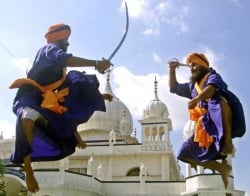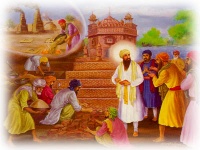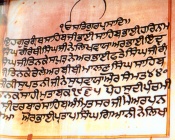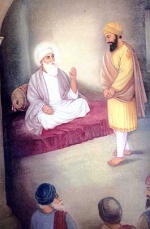Main Page
Welcome to SikhiWiki,a free Sikh Encyclopedia that anyone can edit.
|
| Sunday May 19, 2024 |
Structure of Guru Granth SahibThe Guru Granth Sahib begins with the word "Ek Onkar" – The All Pervading Being. From this Word to the tenth Word “Gur-parshad” is called the Mool Mantra. After this is the rest of the composition called the Japji composed by Guru Nanak Dev. This comprises 38 Pauris or stanzas, a Prologue and an Epilogue. This is one of the morning prayer of the Sikhs. The next composition has two parts - (1) "So Dar" and (2) "So Purkh". The Bani, "So Dar" contains 5 Shabads and "So Purkh" contains 4 Shabads. This form most of the evening prayer of the Sikhs and is called the Rehras. After this is the Bani called Sohila (full name, Kirtan Sohila), which contains 5 Shabads and is the bed-time prayer. Within it's 1430 pages, most of the Shabads (hymns) of the Sri Guru Granth Sahib are arranged in thirty-one Ragas, the traditional Indian musical measures and scales. ....Continued.  Gatka is an ancient martial art which has been thoroughly battle-tested and has existed in northern India for many thousands of years. Although it uses the sword or (kirpan) as its primary weapon, many other weapons are available to the Gatka master. Today, this art exists exclusively amongst the Sikhs who have passed down the flamboyant techniques through generations, since their sixth Guru, Guru Hargobind wore the two swords of Miri (temporal, worldly) and Piri (spiritual, transcendental). The Sikhs have been responsible for the revival of this early art ensuring it's survival despite mass persecution of the native population in India by foreign invaders like the Mughals and others for many hundreds of years. Gatka is a complete martial system which uses spiritual, mental and physical skills in equal portions to help one become fully competent in defending themselves and others. It is a system that can only be used as a last resort: "When all other means have failed, it is proper to take the sword in one’s hand" (Guru Gobind Singh) .....More |
Wallpapers Click on the photo, wait for large image to load - then right button and select "Set as Desktop background". For more pictures goto Flickr: Photos relating to Sikh(s) | ||
Section for Young Sikhs:
Bhai Lehna decided to stay with Guru Nanak at Kartarpur. However, Bhai Lehna’s companions left without him and continued their journey for Jawalamukhi to worship the goddess Durga. After staying for a few days at Kartarpur, Bhai sahib said to himself, ‘Let me go to my village and tell my family and friends about my plans to stay with Guru Nanak. Then I shall come back and stay with the Guru for a longer period and no one will worry about my whereabouts.’' Bhai sahib then went back to his village called Khadur Sahib in district Amritsar. He stayed at his village for a few days only but soon, he was ready to return to Kartarpur as he wanted to be with the Guru. He had enjoyed being in the company of the Guru and the Sangat; he wanted to learn from the Guru and to serve him and the community; this was the custom in those days. He wanted to become a disciple of Guru Nanak and learn true wisdom about life from him. Before starting his journey back, he said to himself, ‘I must take something with me for the Guru. He runs a free kitchen. Scores of people take their meals from there. They do not have to pay anything for the meals. I should take something for the Langar or "free kitchen for all". But what should I take? Yes, let it be as heavy a load of salt as I can carry on my head.’ ....Continued. Important Links: Learning Gurmukhi/Punjabi | |||
The Guru's Message...Recognise the Will of the Lord:- Maharaj guides us thus: "By the Hukam of His Command, He unites those who recognize the Word of the Shabad.(1) By the Fear of the True Guru, doubt and fear are dispelled. Imbued with His Fear, we are absorbed in the Love of the True One." and also "Meeting the Guru, all wisdom and understanding are obtained. The mind becomes pure, when the True Lord dwells within. When one dwells in Truth, all actions become true. The ultimate action is to contemplate the Word of the Shabad.(3)" (page 157)Through Love you will find God:- The Guru guides us thus: "In the Fear of God, is the Love of God. Only those few who understand His Love obtain the sublime essence of the Lord, O Siblings of Destiny. As many hearts as there are - in all of them, is His Ambrosial Nectar; as He pleases, He causes them to drink it in.(2) There are nine gates to the one city of the body; restrain your mind from escaping through them. When the knot of the three qualities is untied, then the Tenth Gate opens up, and the mind is intoxicated, O Siblings of Destiny.(3)" (page 1123)  Gurdwara under construction during the time of the Gurus with the donations from the Sangat Dasvandh or Dasaundh, literally means a "tenth part" and refers to the practice among Sikhs of contributing in the name of the Guru one-tenth of their earnings towards the common resources of the community. This is their religious obligation — a religious requirement or duty; a form of seva or humble service which is highly valued in the Sikh system. The concept of dasvandh was implicit in Guru Nanak’s own Gurbani in the line: "ਘਾਲਿ ਖਾਇ ਕਿਛੁ ਹਥਹੁ ਦੇਇ ॥ ਨਾਨਕ ਰਾਹੁ ਪਛਾਣਹਿ ਸੇਇ ॥੧॥ One who works for what he eats, and gives some of what he has - O Nanak, he knows the Path (1)" (SGGS p 1245) The idea of sharing and giving is symbolised by the institutions of langar (community kitchen) for the sangat (holy assembly) that the Guru has established. In the time of Guru Amar Das, Nanak III, a formal structure for channelizing Sikh religious giving was evolved. The Guru set up 22 manjis or districts in different parts of the country, each placed under the charge of a pious Sikh who, besides preaching Guru Nanak's word, looked after the sangats within his/her jurisdiction and transmitted the disciple’s offerings to the Guru. .....More
Picture Feature:
|
| Popular Articles on Sikhi Wiki |
|
Mool Mantar | Japji | Sikhism | Dasam Granth | Kirtan | Beliefs | Bani | Gurus | SGGS | Bhai Manjh | Vegetarianism | Bhagat Sain | Bhagat Dhanna | Today | Blogs |









